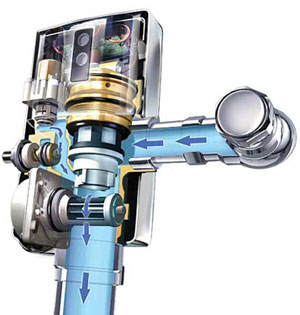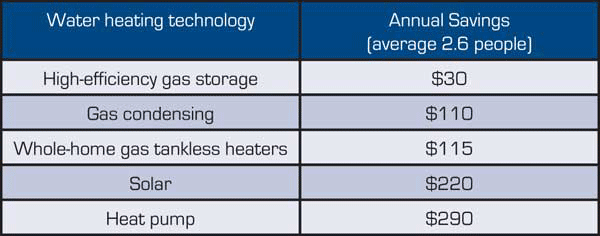Conserving Water for a Thirsty Planet
Faucets and Showers
 |
Cut-away of a faucet that uses a water turbine. Photo courtesy of TOTO USA |
Medical professionals and mothers agree, hand washing is the best way to avoid illness. New water faucets make good hygiene easier and some energy efficient faucets appear to supply an endless supply of water for washing while limiting water waste. Water faucets which do not supply enough power to rinse soap are not a good choice for water saving. Studies show that if a low flow fixture does not deliver enough water to the consumer, then it is often tampered with, aerators are removed or the water use is increased as the consumer attempts to accommodate the lack of rinse capability.
The LEED 2009 V3 utilizes the EPA's 1992 regulations as baseline for faucet aerators in private applications (hotel or motel guest rooms, hospital patient rooms) at 2.2 gallons per minute (gpm) at 60 psi. All other applications will use a baseline 0.5 (gpm) at 60 psi. "The baseline for metering faucets is 0.25 gallons per cycle. Water conserving 0.5 gpm aerators squeeze water into a pressurized spray," says Sean Martin, "so that users cannot tell a significant difference in water consumption." Touchless faucet sensors can be operated by electric eyes, infrared sensors, proximity detectors or motion sensors and their batteries can be powered by solar cells. The latest smart technology uses the water itself as a source of power. This water turbine regenerates the battery as the faucet is used providing almost energy free battery power to the units.
Residential consumers often are not happy with slower rates of water, particularly when washing dishes. For now, kitchen faucets may need to be at the higher flow rate of 2.5 gpm, and to compensate, new sensors will regulate water flow as needed.
"Showering represents approximately 17 percent of residential indoor water use in the United States - more than 1.2 trillion gallons of water consumed each year."8Â WaterSense key performance indicators for a good shower are pressure compensation, spray pattern, and effectiveness of the showerhead force. Although water experts say that there is little difference betweekn a 1.5 and 1.75 gpm shower, often the consumer resists lower flow shower aerators. Today consumers spend more and more time in the bathroom and typical residential bathroom are more like spa settings with whole body showers, large tubs, and multiple sinks.
Zurn's Sean Martin believes that consumer behavior modification will be an important part of managing the new flow fixtures. Particularly in dormitories there is a resistance to low flow showerheads. Education programs will help, but another solution may be new sensors which meter the amount of time a shower flows. Some new sensors can even regulate the timing of hot water to start when the occupant enters the showers.
ENERGY STAR - Hot Water Equipment
Laundry accounts for over 21 percent of water usage in the home. An average family runs approximately 400 loads of laundry per year. The EPA says that replacing pre-1999 washers can save the consumer over $145 per year. New washing machines can cut water and energy by over 40 percent. These new machines have no central agitator. They provide high-speed spin cycles, which have the added bonus of saving energy by requiring less drying time.9 ENERGY STAR steam washing machines can use as much as 77 percent less water and 81 percent less energy than the older models.
Other types of residential equipment that can save water are new dishwashers, which both conserve energy as well as water. ENERGY STAR-qualified dishwashers use at least 41 percent less energy than the federal minimum standard fcor energy consumption. Consumers should always run the dishwater with a full load and use an air-dry option for drying. Most of the energy used by the dishwasher is from heating water and hot water is a critical piece of the water and energy saving equation. Booster heaters which raise water temperature to the 140 degrees recommended for dish washing are sometimes automatic or require manual selection. Booster heaters allow the homeowner to save money by dialing down the thermostat on the main water heater.
Heating and distributing hot water is expensive in both commercial and residential applications. Hot water heating accounts for approximately 18 percent of the household energy budget. The basic principals for design of an efficient hot water system include:
- Providing the heat source near the point of demand
- Use convection and heat exchanges to re-use and recycle hot water
New water heating technology can provide the following savings:

High efficiency water heaters have better insulation, more efficient burners and vents and are designed to save energy. New tankless hot water heaters can often be located near the source of water demand, removing long plumbing runs to distant bathrooms in homes and offices.
Hot water solar systems reduce heating but require sites which are:
- Receive direct sunlight between the hours of 10 am and 4 pm year round
- Face within 15 degrees of south
- Designed to integrate within the roof structural system
- Have freeze protection in some climates
Waiting for hot water to reach the faucet is one of many ways that water is wasted. Cross linked polyethelyne tubing has been used since the 1960's for hot and cold distribution and for radiant heating. These systems run individual smaller, hot and cold supply lines throughout a system with "breakers" close to the demand source shortening the time for hot water to be supplied to the faucet.
Recirculating water and using heat exchange systems is another way to save water and energy. Buildings can be designed to use the heat storage properties of water to save energy.









